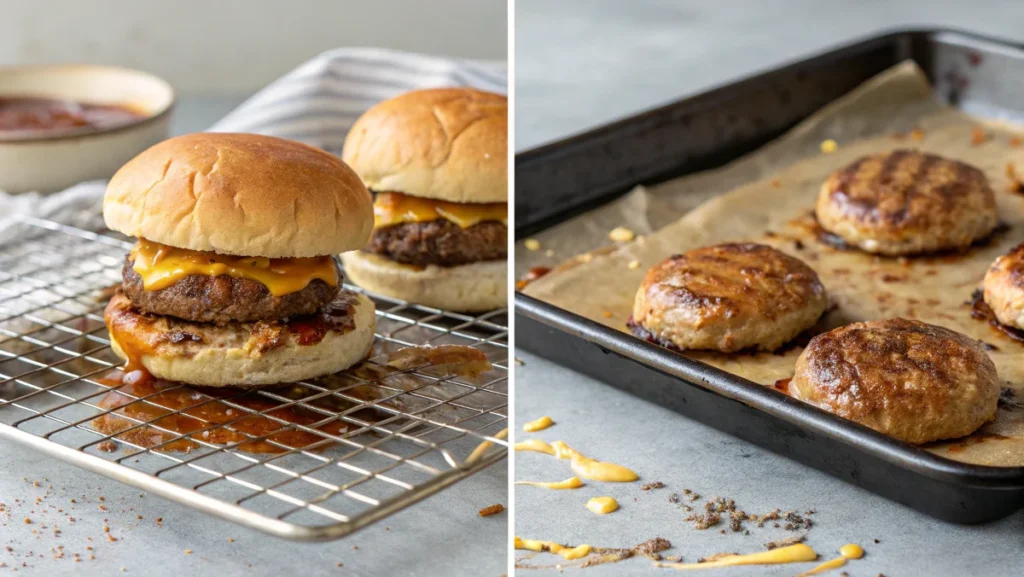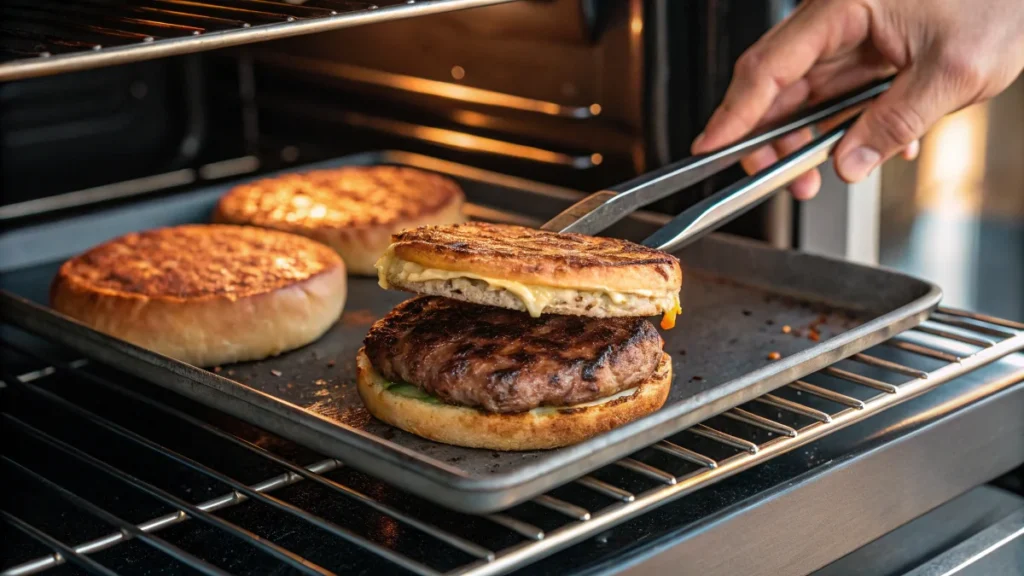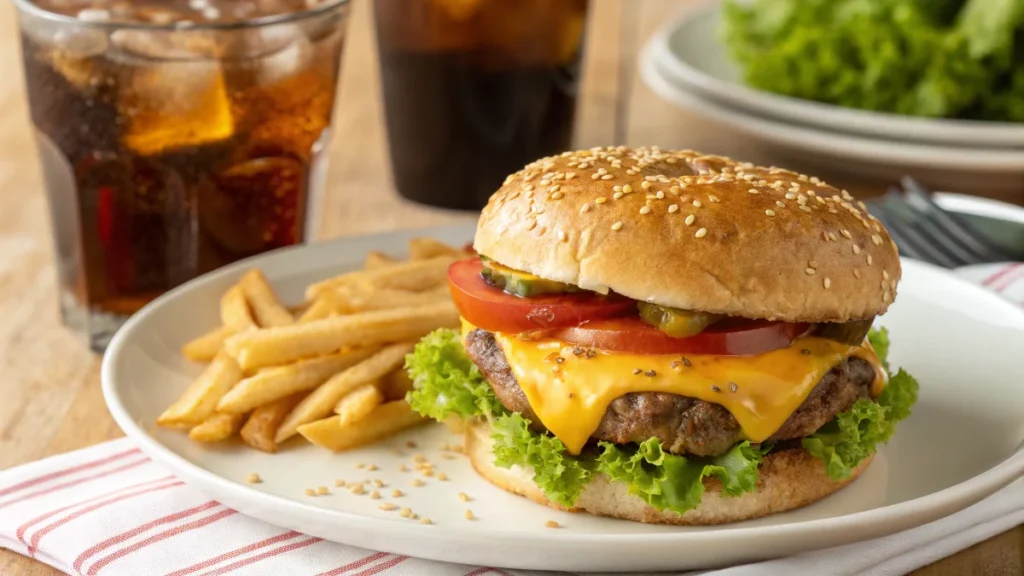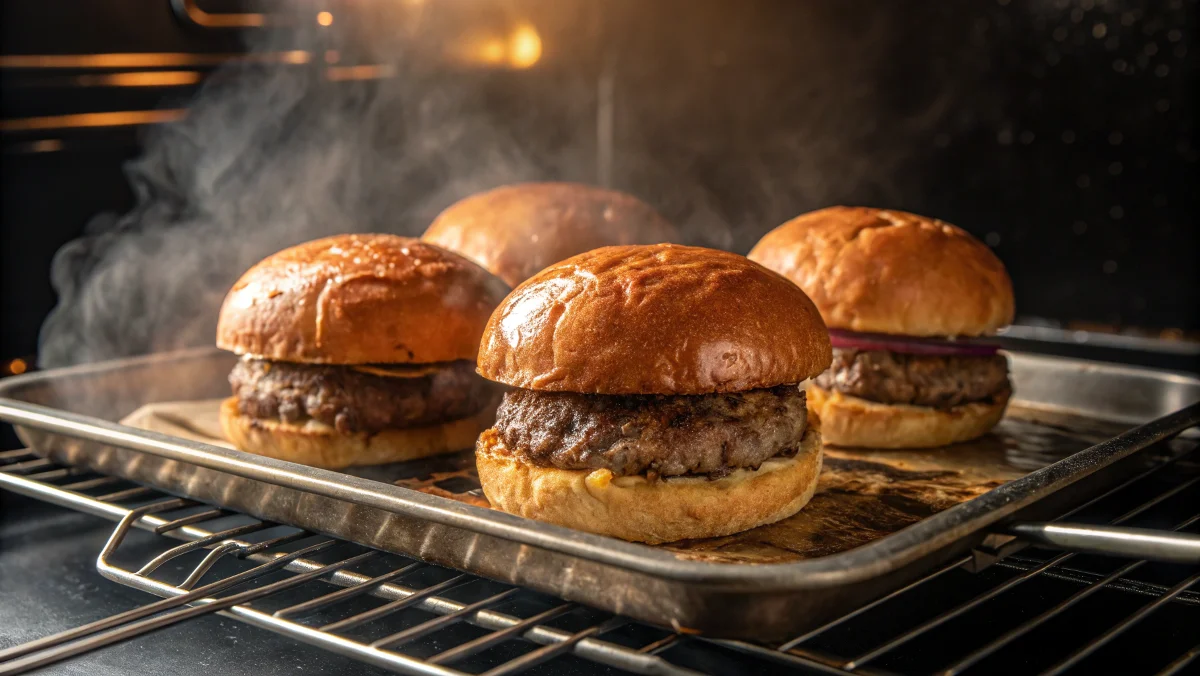Cooking burgers in the oven has become a popular method for home chefs looking for a simple, mess-free alternative to grilling. But when you bake burgers in the oven, a common question often arises: is flipping the patties during the baking process necessary? The answer isn’t as straightforward as it seems—it depends on several factors, such as the cooking tools, the desired texture, and the chosen method for baking burgers in the oven.
For a comprehensive guide on achieving perfectly juicy and flavorful patties, check out Burgers in the Oven: The Ultimate Guide to Juicy Homemade Patties. This resource explores everything from preparation techniques to expert tips for success.
In this article, we’ll also cover the basics of cooking burgers in the oven, delve into whether flipping is required, and provide our own insights for crafting the perfect oven-baked burger. Let’s uncover the secrets to flavorful results.
Table of Contents
The Basics of Cooking Burgers in the Oven
What Happens When You Cook Burgers in the Oven?
Baking burgers is an excellent method because it offers even heat distribution. Unlike grilling, which exposes patties to open flames, oven cooking surrounds the burger with consistent heat. This approach minimizes the risk of burning and helps retain the natural juices of the meat.
Additionally, baking burgers in the oven eliminates the need for constant monitoring. You can set a timer, prepare your sides, and come back to perfectly cooked patties.
Advantages of Baking Burgers
- Hands-Free Cooking: Oven cooking allows you to multitask without worrying about flipping constantly.
- Cleaner Cooking: Grease splatters are contained, making cleanup easier.
- Batch Cooking: You can prepare multiple patties simultaneously, making it ideal for family dinners or parties.
Should You Flip Burgers in the Oven?
The Science Behind Flipping Burgers
Flipping burgers during the cooking process has its benefits. It allows both sides of the patty to develop a nice crust, thanks to the Maillard reaction. This reaction occurs when proteins and sugars interact under heat, creating a golden-brown exterior and enhanced flavor.
Flipping also helps distribute heat evenly, ensuring that thicker patties cook thoroughly without leaving raw spots.
When Flipping Isn’t Necessary
If you use a broiler pan or a wire rack, flipping might not be required. These tools allow hot air to circulate around the burger, cooking it evenly on both sides without manual intervention. However, if you’re using a flat baking sheet, flipping halfway through is recommended for a balanced cook and better browning.
For detailed instructions and optimal cooking times, explore How Long to Cook Burgers at 400 Degrees in the Oven: A Complete Guide. This guide provides precise cooking tips to help you achieve juicy and perfectly cooked burgers every time.
By understanding your tools and methods, you can customize your approach to cooking burgers in the oven for the best results.

Step-by-Step Guide to Baking Perfect Burgers
Ingredients You’ll Need
- Protein of Choice: Ground beef, turkey, chicken, or plant-based alternatives.
- Seasonings: Salt, pepper, garlic powder, onion powder, and optional spices like paprika.
- Optional Additions: Cheese slices, sautéed onions, or cooked bacon for extra flavor.
Preparation Tips for Juicy Burgers
- Choose the Right Meat: For beef burgers, opt for an 80/20 fat-to-lean ratio to keep the patties moist.
- Shape the Patties: Use your hands to form uniform patties about ¾-inch thick. Press a small indentation in the center to prevent puffing during cooking.
- Preheat the Oven: Set the temperature to 400°F (204°C) for an ideal balance of cooking speed and browning.
Cooking Instructions
- Line a baking sheet with aluminum foil or parchment paper for easy cleanup.
- Arrange the patties on the sheet, ensuring there’s at least 1 inch of space between them.
- Bake for 20 minutes, flipping halfway if using a flat sheet.
- Check doneness with a meat thermometer. For beef, aim for an internal temperature of 160°F, and for poultry, 165°F.

Tips for Customizing Oven-Baked Burgers
Adding Cheese
If you’re a cheese lover, timing is everything. Place a slice of cheese on each patty during the last 2 minutes of baking. The residual heat will melt the cheese perfectly without overcooking it. Popular choices include cheddar, Swiss, pepper jack, and provolone.
Experimenting with Toppings
Take your oven-baked burgers to the next level with creative toppings. Here are a few ideas:
- Classic Toppings: Lettuce, tomato, onions, and pickles.
- Gourmet Additions: Avocado slices, blue cheese crumbles, or sautéed mushrooms.
- Sauces: Try garlic aioli, barbecue sauce, or spicy mayo for a flavor boost.
Buns Matter Too
Don’t overlook the bun! Toasting your buns in the oven for 2–3 minutes enhances their flavor and texture, providing a satisfying crunch to complement the juicy burger.

Common Mistakes to Avoid
Overcooking Burgers
One of the biggest mistakes in baking burgers is overcooking, which leads to dry patties. Use a meat thermometer to ensure you reach the ideal temperature without exceeding it. For beef, aim for 160°F, and for turkey or chicken, 165°F.
Skipping the Resting Step
After removing the burgers from the oven, let them rest for 5 minutes before serving. This allows the juices to redistribute, making every bite succulent.
Using the Wrong Baking Tools
Cooking on a flat baking sheet traps grease, which can result in soggy burgers. Invest in a broiler pan or wire rack for the best results. These tools allow excess grease to drip away while promoting even cooking.
Best Tools for Baking Burgers
Why Use a Wire Rack or Broiler Pan?
A wire rack or broiler pan ensures even cooking by allowing hot air to circulate around the patties. It also keeps the burgers out of the grease, resulting in a better texture and flavor.
Meat Thermometers: Your Best Friend
Invest in a reliable meat thermometer. It’s the most accurate way to ensure your burgers are cooked perfectly without the guesswork. Look for an instant-read thermometer for quick and easy temperature checks.
Baking Sheets vs. Cast Iron Skillets
While baking sheets are convenient for large batches, a cast iron skillet can provide superior heat retention and help create a beautiful crust. Both are excellent choices depending on your needs.
If you’re curious about other culinary insights, such as the origins of popular foods, you might enjoy learning about What is the Name of Pizza in English?. This article delves into the fascinating history and terminology of one of the world’s favorite dishes.
By choosing the right tools, you can ensure your oven-cooked dishes—whether burgers or other favorites—are both delicious and perfectly cooked.
Benefits of Flipping Burgers in the Oven
Enhanced Texture and Crust
Flipping burgers in the oven ensures that both sides of the patty achieve the golden-brown crust created by the Maillard reaction. This crust not only enhances the flavor but also improves the overall texture of the burger.
Even Cooking
For thicker patties, flipping halfway through the baking process ensures that heat reaches the center evenly. This step is particularly important if you’re not using a wire rack.
Why Some Recipes Skip Flipping
If you’re short on time or prefer a set-it-and-forget-it approach, cooking on a broiler pan eliminates the need to flip. However, the end result might lack the even browning and crispness achieved with flipping.
Oven-Baked Burger Recipes to Try
Classic Beef Burgers
Ingredients:
- 1 lb ground beef (80/20 ratio)
- 1 tsp salt
- ½ tsp black pepper
- ½ tsp garlic powder
Instructions:
- Preheat the oven to 400°F.
- Form beef into 4 patties, pressing a small indent in the center of each.
- Season both sides with salt, pepper, and garlic powder.
- Bake on a wire rack for 20 minutes, flipping halfway through.
Turkey Burgers with a Twist
Ingredients:
- 1 lb ground turkey
- 1 tsp Dijon mustard
- ½ tsp paprika
- 1 minced garlic clove
Instructions:
- Preheat the oven to 375°F.
- Combine all ingredients in a bowl and mix thoroughly.
- Shape into patties and place on a parchment-lined baking sheet.
- Bake for 25 minutes, flipping halfway.
Veggie Burgers
Ingredients:
- 1 can black beans (rinsed and mashed)
- ½ cup breadcrumbs
- 1 tsp cumin
- ½ tsp chili powder
Instructions:
- Preheat the oven to 400°F.
- Mix all ingredients in a bowl until combined.
- Shape into patties and bake for 15–20 minutes, flipping once.
FAQs About Cooking Burgers in the Oven
Do You Have to Turn Burgers in the Oven?
Flipping burgers in the oven depends on how they’re cooked and the tools you use. If you’re using a wire rack or broiler pan, turning the patties is often unnecessary. These tools allow hot air to circulate around the burgers, cooking them evenly on both sides.
However, if you’re using a flat baking sheet, flipping is essential to achieve a perfectly cooked burger. When one side of the patty sits directly on the baking sheet, it browns faster due to contact with the hot surface, while the top remains less cooked. Flipping halfway through ensures even browning and a better overall texture.
Ultimately, flipping the burgers can enhance their flavor by creating a crisp, golden crust on both sides, thanks to the Maillard reaction, a chemical process that adds depth and richness to cooked foods. For best results, flip the burgers once during cooking.
How Long to Bake Burgers at 400 in the Oven?
Baking burgers at 400°F provides a good balance between speed and flavor development. The total cooking time depends on the size and thickness of the patties:
- Thin patties (less than ½ inch thick): 15–18 minutes.
- Medium patties (about ¾ inch thick): 20–25 minutes.
- Thicker patties (1 inch or more): 25–30 minutes.
To ensure perfectly cooked burgers, use a meat thermometer to check the internal temperature. Here’s a quick guide:
- Medium-rare: 135°F (juicy with a hint of pink).
- Medium: 145°F (slightly pink and firm).
- Well-done: 160°F (fully cooked, no pink).
If you’re cooking frozen patties, increase the time by about 5–10 minutes to ensure they’re fully thawed and cooked through.
How Often Should I Flip Burgers at 400?
When baking burgers at 400°F, flipping them once halfway through the cooking time is all that’s needed. Constant flipping isn’t necessary and can disrupt the cooking process, causing the patties to lose their juices and dry out.
For example, if the total cooking time is 20 minutes, flip the burgers after 10 minutes. This timing ensures even cooking and allows both sides to develop a golden-brown crust.
If you’re using a wire rack, flipping may not be required since the rack allows hot air to circulate freely around the patties. However, flipping can still improve texture, particularly if you prefer a more even crust.
For a look at why certain foods, like pizza, become universally loved, check out Why is Supreme Pizza So Good?. It offers a deeper understanding of the flavor combinations that make this classic dish irresistible.
By mastering the flipping technique and using the right tools, you can ensure that your oven-baked burgers come out juicy and perfectly cooked every time.
How Do You Keep Burgers from Splattering in the Oven?
Grease splatter can be a common issue when baking burgers, but it’s manageable with the right techniques. Here are some tips to keep your oven clean and your burgers mess-free:
- Use a Wire Rack or Broiler Pan
A wire rack elevates the burgers, allowing grease to drip into the tray below. This prevents the patties from sitting in their grease, reducing splatter and promoting even cooking. - Line the Baking Tray
Line the tray with aluminum foil or parchment paper to catch grease and simplify cleanup. This method is particularly helpful if you’re not using a wire rack. - Cover the Burgers (Optional)
Loosely tenting the burgers with aluminum foil for the first half of baking can significantly reduce splatter. Just remove the foil during the second half to allow the burgers to brown properly. - Don’t Overcrowd the Pan
Leave at least 1 inch of space between each patty. Overcrowding prevents proper air circulation and can lead to grease pooling, which increases splatter.
By using these methods, you can enjoy juicy oven-baked burgers without the mess!
Conclusion: How to Bake Burgers in the Oven Perfectly
Baking burgers in the oven is a simple yet effective way to create delicious, juicy patties with minimal effort. Whether you decide to flip your burgers or not, the key lies in understanding the tools and techniques that work best for your kitchen setup. Using a wire rack or broiler pan ensures even cooking, while flipping halfway through enhances texture and flavor.
Timing is everything—cooking at 400°F allows you to achieve that perfect balance of a golden crust and a tender interior. If you’re curious about cooking at lower temperatures, explore How Long to Cook Burgers at 350°F: A Complete Cooking Guide for additional tips and techniques.
Preventing splatter and maintaining a clean workspace is easy with a few simple tips, such as lining your baking tray or using a foil tent. With these strategies, you can make oven-baked burgers a go-to meal for family dinners, game nights, or any occasion that calls for a satisfying bite.
Now that you’re armed with all the tips and tricks, it’s time to preheat your oven and get cooking. Experiment with different patties, toppings, and seasonings to find your signature burger style. Whether classic beef or creative veggie options, the possibilities are endless!
Enjoy the ease and flavor of oven-baked burgers, and savor every bite of your culinary success.

